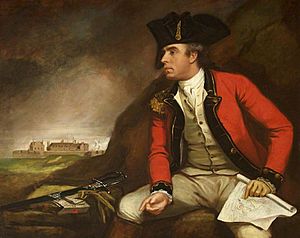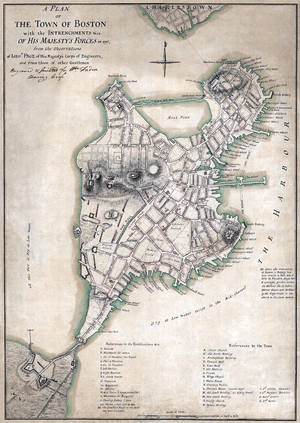Thomas Hyde Page facts for kids
Sir Thomas Hyde Page (1746–1821) was an important British military engineer and mapmaker. He worked for the British government and received many awards for his service. He was also a Fellow of the Royal Society, which means he was part of a special group of top scientists.
Contents
Early Life and Education
Thomas Hyde Page was born in Harley Street, London, England. His father, Robert Hyde Page, was also a military engineer.
Thomas went to the Royal Military Academy, Woolwich, a famous school for military training. He was a very good student and even received a gold medal from King George III himself!
Career as an Engineer
In July 1769, Page became a second lieutenant in the Corps of Royal Engineers. This group of soldiers specializes in building and designing things for the army. He was promoted to sub-lieutenant in 1774.
Improving Drainage and Building Ferries
In 1775, a leader named Lord George Townshend, 1st Marquess Townshend asked Page to study the Bedford Level. This area needed better drainage to prevent floods. Page wrote a report with his ideas, which was kept in a special library.
Page also built a ferry in Chatham, Kent. A ferry is a boat that carries people or vehicles across water. For this project, he won another gold medal, this time from the Royal Society of Arts.
Service in America
Page traveled to North America with the engineers. He showed great bravery during the Battle of Bunker Hill on June 17, 1775. He was badly hurt in this battle. Because of his injury, he received a special payment every day.
Working on Coastal Defenses
After returning to England, Page became the main royal engineer for the eastern coast. He was in charge of fixing and improving forts and defenses in important places like Dover, Chatham, and Sheerness. In 1780, he also helped organize a group of volunteers in Dover to protect the town.
The Sheerness Well Project
In 1782, Page was asked to dig a well at the Sheerness army base. He tried a new way to dig, but it didn't work at first. Some people in the government were upset and said it was a waste of money.
However, Page tried again at Fort Townshend in Sheerness, and this time he succeeded! He wrote a report about how he made the well, and his plans were published in a science journal called the Philosophical Transactions of the Royal Society.
Becoming a Knight
Page was a very respected engineer. In 1783, he became a Fellow of the Royal Society. This honor meant he was recognized as an expert in mechanics and science. On August 23, 1783, he was given the title of "Sir," becoming Sir Thomas Hyde Page.
He continued to be promoted in the army, becoming a captain-lieutenant in 1784 and a captain in 1787.
Helping with Irish Waterways
Even after moving to a different part of the engineering corps, Page's skills were still needed. He became the main consulting engineer for improving the port of Dublin and other harbors in Ireland. He also worked on important canals and rivers, like the Royal Canal and the river Shannon, to help boats travel more easily. In 1792, he helped fix a break in a canal in Dublin.
Solving a Long-Standing Problem
Page also worked on a big project in England called "The Eau Brink Cut." This was a new channel for the River Great Ouse in Norfolk. Engineers had been trying to solve the problems of navigation and drainage in this area since the 1600s, and Page finally helped find a solution.
Later Years
Sir Thomas Hyde Page lived for many years at Betshanger Park in Kent, England. Later in his life, he moved to France for health reasons. He passed away in Boulogne-sur-Mer, France, on June 30, 1821, and was buried there.
Selected Works
- Page, Thomas Hyde, "Considerations upon the state of Dover-harbour..." (1784)
- Page, Thomas Hyde, "The reports or observations of Sir Thomas Hyde Page on the means of draining the south and middle levels of the Fens" (1794)
- Page, Thomas Hyde; Mylne, Robert, Correspondence Upon The Subject Of The Eau-Brink Cut... (1802)



